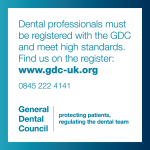Fixed orthodontic braces
These are the most commonly used braces. Individual brackets are glued on the teeth and orthodontic wires are used to allow accurate positioning of the teeth.
Different types of fixed braces are used from small metal brackets to clear, aesthetic brackets. Teeth are not white and the aesthetic brackets we use are clear to make them less visible. Some 'tooth coloured' wires are available; however, it may not be possible to complete treatment for all cases using aesthetic wires as the full range of orthodontic wires is not available in an aesthetic form
Brackets are usually placed on the outside of the teeth but can on occasions be placed on the inside of the teeth, thes are called lingual braces.
Quadhelix
When a patient has a cross bite this can be treated with a quadhelix appliance which is fitted to the back teeth of the upper jaw. The quadhelix gently pushed the teeth and gently expands the upper jaw to match with the lower jaw and correct the cross bite.
Rapid Maxillary Expansion
Sometimes a cross bite this can be treated with a rapid maxillary expansion device appliance which is fitted to the back teeth of the upper jaw. The expansion device has a special screw which is turned by the patient at frequent intervals to widen the upper jaw to match with the lower jaw and correct the cross bite.
Clear Aligners
Clear aligners such as Invisalign® appliances are almost invisible. A series of clear plastic aligners are fabricated and are usually changed every one to three weeks. They are worn fulltime but removed for eating and brushing your teeth. Invisalign® braces are computer designed and Nigel Taylor has been trained by Align Technologies, the company that manufactures Invisalign.
Removable Braces
These are removable from the mouth and are used for some simple tooth movements. They are made up of delicate wires and springs, which apply gentle forces to the teeth.
Functional Braces
A functional appliance is a removable brace that treats upper and lower teeth at the same time using the muscles of the jaws to help correct the bite and reduce the prominence of front teeth.
Retainer Braces
It is important to remember that your teeth can move throughout life whether or not you have had braces. At the end of treatment you will be provided with retainers which are designed to keep your teeth straight. My usual advice is to wear retainers full time for four to six months following completion of treatment; then retainers are worn at night time for a further four to six months. Retainer wear is recommended for one to two nights a week for an indefinite period of time. Clean retainer braces with soap and water or special cleaning tablets; toothpaste can damage clear retainers.
Retainers should be worn for as long as you wish to keep your teeth straight.
There are different styles of retainer brace. A Hawley type of retainer is described below
Clear retainers are less visible but more easily lost. It is important to keep the retainer in a box when not in the mouth. Retainers in tissues are easily thrown away and lost.
The British Orthodontic society has produced a video about the importance of wearing retainers.



